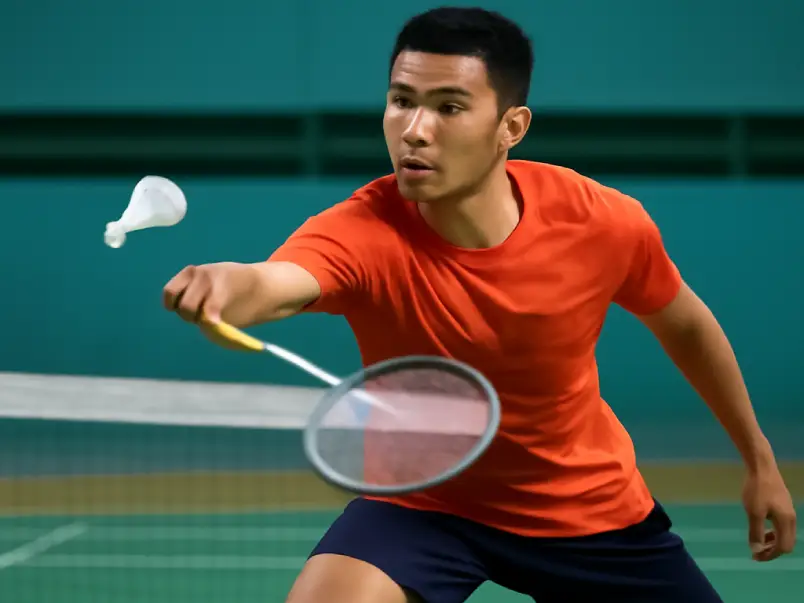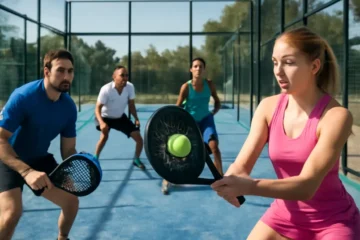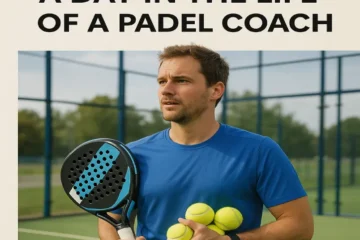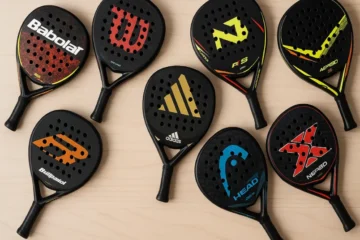Badminton is a fast-paced sport that demands a wide range of skills, from powerful smashes to delicate net play. One shot that has gained attention in recent years for its ability to disrupt opponents’ rhythms is the Chiquita shot. Often mistaken for just a trick shot, the Chiquita is a deceptive and offensive net lift that can be a game-changer when executed properly. In this comprehensive guide, we’ll break down the purpose, tactical situations, execution, and risks of the Chiquita shot, helping you add this potent weapon to your badminton arsenal.
I. More Than Just a Trick Shot
Imagine this: You’re at the net, and the shuttlecock comes at you fast. You’re forced into a tight net shot position, and your opponent is moving quickly to close the gap. You need to make a quick decision. Do you lift the shuttle high, or is there a better way to gain an advantage? Enter the Chiquita. This shot, often attributed to Indonesian legend Taufik Hidayat, is a deceptive and offensive lift aimed at catching your opponent off guard.
Named after the banana brand, the Chiquita gets its name due to the shot’s flight path resembling the curve of a banana. Instead of lifting the shuttle high to the rear court like traditional net lifts, the Chiquita flies low, fast, and flat towards the mid-court, making it a deadly weapon. This article will explain when and how to use the Chiquita shot, so you can add this effective weapon to your badminton playbook.
II. Demystifying the Chiquita: What It Is and What It Isn’t
A. The Chiquita vs. The Traditional Net Lift
To understand the Chiquita, it’s essential to first distinguish it from the traditional net lift.
- Traditional Net Lift: The traditional lift is a defensive shot played when you’re under pressure at the net. The shot is executed by lifting the shuttle high and deep into the opponent’s rear court. This gives you time to recover and reposition yourself for the next shot. The objective is to buy time and reset the rally.
- Chiquita: On the other hand, the Chiquita is an offensive shot that is flatter and faster. It is played with the intent of putting pressure on your opponent by aiming for the mid-court, either directly in front of them or between their feet. The Chiquita is meant to intercept your opponent’s forward momentum, disrupt their rhythm, and create a more aggressive transition for you or your partner.
B. The Core Objective
The core objective of the Chiquita shot is to move from a defensive posture to an offensive one quickly. By keeping the shuttle low and fast, the Chiquita catches your opponent off guard. Instead of being predictable, it adds an element of surprise and forces your opponent to make quick decisions. This helps to break their rhythm and keeps them guessing, setting up potential attacking opportunities for you.
III. The Perfect Moment: When to Deploy the Chiquita
The Chiquita isn’t a shot you should use on every rally. Instead, it’s a weapon that comes into play in specific situations. Let’s look at the best times to use the Chiquita shot.
A. Against a Rushing Opponent
One of the best times to use the Chiquita is when your opponent is rushing forward. This usually happens when your opponent anticipates a simple net shot and moves in quickly to intercept it. By executing a Chiquita, you can fly the shuttle over their racket shoulder, catching them off guard and preventing them from reaching the shuttle in time. The shot’s deceptive nature forces them to rethink their approach.
B. To Exploit a Weak Mid-Court Position
Another ideal time for the Chiquita is when your opponent is caught out of position, particularly when they are too slow to recover to the center of the court. If they’re flat-footed or caught on the wrong foot after their own shot, you can take advantage of this moment by playing a Chiquita. A flat shot to the mid-court will put immediate pressure on them and force them to scramble.
C. In Doubles, to Create Interception Opportunities
In doubles, the Chiquita shot can be particularly effective in creating confusion between your opponents. If you’re at the net and your opponents are spread out, a well-placed Chiquita to the center can make them hesitate and potentially cause an interception opportunity for your partner. The speed and accuracy of the shot make it difficult to predict, giving you an edge in quick exchanges.
D. To Break a Rhythm of Defensive Lifts
If you’ve been stuck in a cycle of lifting the shuttle defensively and your opponent is becoming accustomed to your lifts, the Chiquita can be a fantastic change of pace. This shot can disrupt your opponent’s rhythm and prevent them from anticipating your next move. A quick, sharp change in shot style can create an opening for an offensive transition.
E. As a Variation from Tumbling Net Spins
If you’ve been hitting a series of tumbling net shots that are tricky but somewhat predictable, you can use the Chiquita as a surprise change-up. After playing several spinning net shots, the Chiquita will feel fresh and unexpected, giving you an upper hand when your opponent least expects it.
IV. Executing the Shot: Technique is Everything
Executing the Chiquita properly requires precision, control, and a lot of finesse. The key to mastering this shot lies in its deceptive nature, the angle of the shuttle, and the placement.
A. The Grip and Ready Position
For the Chiquita, you’ll want to use a standard forehand grip, but with a relaxed “fingers” grip for maximum sensitivity and flexibility. This relaxed grip helps you adjust the angle of the shuttle at the last moment, giving you better control over the shot’s flight path. Keep your body low and balanced with a slight bend in your knees, ensuring that you can react quickly to incoming shuttles.
B. The Deception: The “Pushing” Action
The key to executing a successful Chiquita lies in the deception. Instead of using a big swing, the shot is played with a quick, sharp “pushing” motion from the wrist and fingers. You’ll want to disguise it as a simple net shot or a net kill. The late change in the angle of your racket, from looking like a typical net shot to suddenly sending the shuttle flat and fast, is what catches your opponent off guard.
C. Trajectory and Placement
The trajectory of the Chiquita is critical. Ideally, the shuttle should travel just high enough to pass over the net player’s racket in doubles, but low enough to avoid being smashed by your opponent. The shot’s flat trajectory makes it harder to return, especially when placed well.
- Key Placements:
- In doubles, aim for the “V” between the two players. A well-placed shot in this area can lead to confusion between your opponents, making it easier to exploit gaps in their defense.
- In singles, aim for the opponent’s backhand shoulder. This is often a vulnerable area, and placing the shuttle here can make it harder for your opponent to reach the shot.
D. Common Mistakes to Avoid
There are several pitfalls you should watch out for when attempting the Chiquita:
- Hitting it too high: A high shot will become easy prey for a smash, so ensure the trajectory remains low and controlled.
- Hitting it too wide: Make sure you aim for the correct placement to avoid the shuttle going out of bounds.
- Being too predictable: If you use the Chiquita repeatedly in the same spot, your opponent will catch on. Vary your placement and timing to maintain the surprise element.
V. Weighing the Risks: When NOT to Use the Chiquita
While the Chiquita is a potent offensive weapon, it’s not always the best choice in every situation. Here are times when you should avoid using this shot.
A. Against a Tall, Ready Net Player
If your opponent is positioned at the net with their racket already up and ready, the Chiquita becomes much easier for them to intercept. In this case, a high defensive lift or a more neutral net shot might be the safer option.
B. When You Are Off-Balance or Late to the Shuttle
Executing the Chiquita requires excellent body control and timing. If you’re stretched or late to reach the shuttle, the shot may not be effective. Instead, opt for a safer, more stable high lift to reset the rally.
C. If Your Opponent is Already in a Defensive Stance
The Chiquita thrives on catching opponents off guard. If your opponent is already in a defensive stance, poised to react, the element of surprise is lost, and the shot becomes less effective.
VI. Drilling the Chiquita: How to Practice
To perfect the Chiquita, you need to practice regularly. Here are a few drills to help you improve your technique:
A. Solo Drill
Start by practicing the short, sharp “push” motion against a wall. Focus on making the shuttle fly low and fast, maintaining control while practicing the deception of the shot.
B. Partner Drill
With a partner, play net shots to each other. Alternate between lifting and playing the Chiquita to work on your decision-making and disguise. This will help you choose the right shot under pressure.
C. Multi-Shuttle Drill
In this drill, a coach feeds multiple shuttles rapidly to the net. This simulates match conditions and forces you to react quickly, deciding whether to play a Chiquita or another shot.
VII. Conclusion: Elevate Your Net Game
The Chiquita shot is a tactical, offensive weapon that can elevate your net game, allowing you to disrupt your opponent’s rhythm and transition from defense to attack quickly. By understanding when and how to use this shot, you’ll be able to create opportunities that put you in a dominant position. Remember, it’s not a replacement for solid net play but a sophisticated tool to add variety and surprise to your game. With practice and proper execution, the Chiquita will become an essential part of your badminton strategy.
FAQs
1. What is the Chiquita shot in badminton?
The Chiquita shot is a deceptive and offensive net lift that travels flat and fast to the mid-court. Unlike traditional net lifts that go high and deep to the rear court, the Chiquita aims to catch opponents off guard by staying low and fast, typically aimed at the sides or middle of the court.
2. When should I use the Chiquita shot?
The Chiquita is most effective when your opponent is rushing forward or is caught off-balance in the mid-court. It’s also useful to break the rhythm of defensive lifts, in doubles to create interception opportunities, and as a surprise change from other net shots like tumbling net spins.
3. How do you execute the Chiquita shot?
To execute the Chiquita, use a relaxed forehand grip and a short, sharp “pushing” action from the wrist and fingers, rather than a full swing. Focus on keeping the shuttle low and fast, aiming for the opponent’s backhand shoulder or the “V” between the two players in doubles.
4. What are the common mistakes to avoid when using the Chiquita?
Some common mistakes include hitting the shuttle too high, which makes it vulnerable to smashes, or too wide, causing the shot to go out of bounds. It’s also important to vary your placements to avoid being too predictable.
5. Is the Chiquita shot suitable for all players?
While the Chiquita can be a potent weapon, it requires good body control, balance, and timing. It may not be effective if you’re off-balance or against an opponent who is ready at the net. Make sure to use it at the right moments for maximum effectiveness.
6. Can the Chiquita shot be used in doubles?
Yes, the Chiquita is particularly effective in doubles. It can create confusion between the opponents and set up opportunities for your partner to intercept the shuttle. A well-placed Chiquita to the center of the court is especially useful for this purpose.
7. How can I practice the Chiquita shot?
To practice the Chiquita, try solo drills by hitting the shuttle against a wall with a short, pushing motion. Partner drills are also effective for working on decision-making and disguise, while multi-shuttle drills with a coach can simulate real match conditions to improve your reaction time and shot selection.
8. What are the risks of the Chiquita shot?
The Chiquita is risky when facing a tall, ready net player who can easily intercept it. It’s also less effective when you’re out of position or when your opponent is already in a defensive stance. Be sure to assess your opponent’s position before attempting the shot.




